|
|
|
Sort Order |
|
|
|
Items / Page
|
|
|
|
|
|
|
| Srl | Item |
| 1 |
ID:
183361
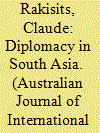

|
|
|
|
|
| Summary/Abstract |
In this Commentary, I propose a bold, four-step plan which would address the question of self-determination for Kashmiris and hopefully resolve permanently the 70-year-old Kashmir issue which has poisoned Indo-Pakistan relations since Partition. Two important elements of this plan would be: first, the involvement of the Commonwealth Eminent Persons Group to assist Kashmiris, Pakistan and India in the mediation of the plan; and, second, the holding of four UN-supervised referenda which would be held simultaneously but counted separately: Gilgit-Baltistan and Azad Kashmir; Kashmir valley; Jammu; and Ladakh. All Kashmiris would have three options: Join Pakistan, Join India or independence. As an incentive to India and Pakistan, the international community would deliver substantial economic assistance for the development of all parts of Kashmir. But as a quid pro quo for the economic aid package, there would have to be guaranteed free movement of people, capital and goods between all parts of Kashmir after the referenda, regardless as to which option had been chosen by the Kashmiris.
|
|
|
|
|
|
|
|
|
|
|
|
|
|
|
|
| 2 |
ID:
183365
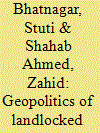

|
|
|
|
|
| Summary/Abstract |
Foreign policies of landlocked states have been a topic of interest for scholarship on international relations but the landlocked states in South Asia have received negligible attention. Due to their geographical realities, South Asian landlocked states that include Afghanistan, Bhutan and Nepal, depend on their neighbours for trade with the outside world. A range of factors place landlocked states in an unequal relationship with their coastal neighbours. While these factors include the superiority of coastal neighbours in terms of economy, population size, and military strength, we argue that their landlockedness plays a crucial role. To further investigate the role of landlockedness, this study compares the foreign policy decisions that guide India-Nepal and Afghanistan–Pakistan relations. Based on the assessment of historical, economic and geopolitical factors, we argue that India and Pakistan exploit their landlocked neighbours to achieve their national interests. Frustrated by the treatment of their coastal neighbours and the presence of new trade opportunities have compelled Afghanistan to use its closeness with India to counter over-dependence on Pakistan and Nepal has enhanced cooperation with China to overcome its reliance on India, thereby creating a new geopolitical dynamic within South Asia.
|
|
|
|
|
|
|
|
|
|
|
|
|
|
|
|
| 3 |
ID:
183364
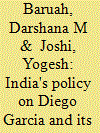

|
|
|
|
|
| Summary/Abstract |
The ongoing contention between Mauritius and the UK over the sovereignty of the Diego Garcia presents a difficult challenge for Indian foreign policy-makers. New Delhi's principled opposition to colonialism and its historical relationship with Port Louis has made it steadfastly support the Mauritian claim. However, such principled foreign policy militates against India's quest to balance the growing Chinese influence in the Indian Ocean. Insofar, Diego Garcia allows the US Navy to maintain an active presence in the Indian Ocean, thereby keeping the Chinese naval power at bay. Balance of power considerations notwithstanding, the expanding trajectory of the Indo-US strategic partnership also demands New Delhi to weigh the burden of its policies on Diego Garcia carefully. This article juxtaposes India's historical record on Diego Garcia during the Cold War with its contemporary approach to the issue. In doing so, it sheds further light on India's strategic decision-making in the Indian Ocean, its dilemmas in confronting a genuinely hostile maritime power in the region, and deliberates on potential options for dispute resolution which can not only satisfy Mauritian demands but also ensure a healthy balance of power in the Indian Ocean.
|
|
|
|
|
|
|
|
|
|
|
|
|
|
|
|
| 4 |
ID:
183363
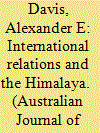

|
|
|
|
|
| Summary/Abstract |
This article examines international relations (IR)'s approach to the Himalaya. We argue that the possibility of violent conflict over contested international borders is not the region's primary international challenge. Rather, slow violence inflicted by state-building and militarisation, intimately connected to geopolitical tensions, threaten the region's ecologies, cultures and languages. The Himalaya is home to three biodiversity hotspots and a mosaic of ethnic groups, many of whom speak threatened languages. Its ice-deposits feed most of Asia's large rivers. In recent years, India and China have pursued large-scale infrastructure development in the region, enabling greater militarisation and extraction, and a tourist rush. These threats are amplified by climate change, which is occurring in the Himalaya at twice global averages, contributing to landslides, flooding, and droughts. However, the region's complexity is not matched by IR's theorisations, which overwhelmingly focus on the possibility of violent conflict between state actors. We argue that IR's analysis of the region must go beyond a states-and-security, Delhi-Beijing-Islamabad centred approach, to look at the numerous interconnections between its geopolitics, cultures and ecologies. We suggest this can be accomplished through incorporating more interdisciplinary analysis, and through focusing on the interaction between the organisation of political authority and the region's environment.
|
|
|
|
|
|
|
|
|
|
|
|
|
|
|
|
| 5 |
ID:
183366
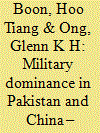

|
|
|
|
|
| Summary/Abstract |
The China–Pakistan Economic Corridor (CPEC) has been touted as the centrepiece of China’s Belt and Road Initiative and the key to its strategic partnership with Pakistan. Notwithstanding claims about the CPEC’s economic potential, however, Islamabad’s economy continues to be dire. This article attempts to better understand the ramifications of Pakistan’s economic viability and its consequences for China. It does so by examining China–Pakistan relations from the lens of Pakistan’s civil–military relations, paying attention in particular to what the Pakistan Armed Forces (PMA)’s domestic dominance means for China’s interests, including economic interests, in Pakistan. We suggest that PMA preponderance and its attendant influence on the country’s economic performance bring another dimension to interpreting Sino-Pakistani relations. As Beijing’s most trusted political partner in Pakistan, the PMA’s local dominance has considerable benefits for China, particularly in the security and political aspects of its interests. However, this dominance also entails a number of complications for Chinese economic interests, a factor that has implications for the future of China’s CPEC investments and their financial sustainability.
|
|
|
|
|
|
|
|
|
|
|
|
|
|
|
|
| 6 |
ID:
183367
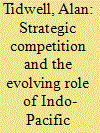

|
|
|
|
|
| Summary/Abstract |
Scholarship on paradiplomacy, or sub-national diplomacy, has often focused on economics, trade, cooperation and politics. The deepening of strategic competition between the People’s Republic of China and the United States has raised the stakes for sub-national diplomacy. While US-PRC strategic competition occurs primarily at the national level, the subnational level plays an important role in terms of creating opportunities for influence and advancing the strategic interests. In this article recent paradiplomacy in the Indo-Pacific is examined, as is the is the intersection of paradiplomacy with strategic competition.
|
|
|
|
|
|
|
|
|
|
|
|
|
|
|
|
| 7 |
ID:
183362


|
|
|
|
|
| Summary/Abstract |
On 29 February 2020, the US and the Taliban signed a peace deal in Doha, Qatar. According to the peace agreement, the US agreed to withdraw 5400 troops from Afghanistan in 135 days reducing its troop strength to 8600. The US and North Atlantic Treaty Organization (NATO) also agreed to withdraw all troops from the country by 30 April 2021. The Taliban on its part agreed that it would prevent Al-Qaeda and other terrorist organizations from planning, organizing and operating attacks against the US and its allies in areas under its control. The Taliban also pledged to participate in an intra-Afghan dialogue to be held on 10 March 2020 in Oslo, Norway. As a confidence building measure, the agreement included a prisoner exchange with 1000 Afghan security personnel to be set free in exchange for 5000 Taliban prisoners by the time the dialogue will take place. The withdrawal of troops, however, is not contingent on the prisoner exchange.
|
|
|
|
|
|
|
|
|
|
|
|
|
|
|
|
|
|
|
|
|